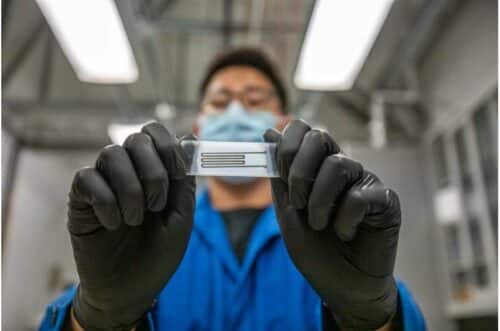This polymer based biodegradable circuit could be a sustainable alternative in transient electronics.
Most electronics on the market today are designed for portability, not recyclability. Tablets and electronic readers are assembled by glueing circuits, chips, and hard drives to thin layers of plastic, which are later melted to extract precious metals like copper and gold. Hence releasing toxic gases into the atmosphere.
Researchers at the Department of Energy’s Lawrence Berkeley National Laboratory (Berkeley Lab) and UC Berkeley have developed a potential solution: a fully recyclable and biodegradable printed circuit.

Credit: Marilyn Sargent/Berkeley Lab
“With this study, we’re showing that even though you can’t solve the whole problem yet, you can at least tackle the problem of recovering heavy metals without polluting the environment,” said Ting Xu, a faculty senior scientist in Berkeley Lab’s Materials Sciences Division, and professor of chemistry and materials science and engineering at UC Berkeley.
The team demonstrated a biodegradable plastic material embedded with purified enzymes such as Burkholderia cepacia lipase (BC-lipase). They discovered that hot-water activates which prompts the enzyme to degrade polymer chains into monomer building blocks.
Lipase first catches the end of the polymer chain before it converts into a monomer. This process was further simplified for experimentation using biodegradable printed circuits that rely on cheaper, shelf-ready BC lipase “cocktails.” This enabled them to develop a printable “conductive ink” composed of biodegradable polyester binders, conductive fillers such as silver flakes or carbon black, and commercially available enzyme cocktails.
The device was tested for durability by putting it in a chamber without controlled heat and humidity for seven months. The device turned out to work efficiently. Later, the researchers put the device’s recyclability to test by immersing it in warm water. Within 72 hours, the circuit materials degraded into its constituent parts—the silver particles completely separated from the polymer binders, and the polymers broken down into reusable monomers, allowing the researchers to easily recover the metals without additional processing.
The circuit also shows promise as a sustainable alternative to single-use plastics used in transient electronics—devices such as biomedical implants or environmental sensors that disintegrate over a period of time.
Now that they’ve demonstrated a biodegradable and recyclable printed circuit, Xu wants to demonstrate a printable, recyclable, and biodegradable microchip.






